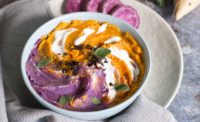Here are the hot buttons for health and nutrition in the New Year.
Snack Food & Wholesale Bakery asked Beth Arndt, director of research and development for ConAgra Mills, to give us her thoughts on what might be the hot buttons for health and nutrition in the New Year. In addition, Mike Veal, director of marketing for the Omaha, Neb.-based company, adds some insights into how fiber is being incorporated into products in unique ways.
Snack Food & Wholesale Bakery:What are the Top 5 consumer health trends that bakers should monitor in 2010? Why did you select these trends?
Beth Arndt: As a result of the updated nutrition guidelines there are a number of trends that will get consumer attention in 2010 and many of those may directly affect bakers. Five key areas of focus for bakers are going to be combating obesity, reducing sodium, whole foods with minimal food processing, improving types of carbohydrates consumed, and improving nutrient shortfalls. These represent opportunities for growth as baked goods can help consumers meet these needs. Whole grains have been a hot button for a while now and are poised to play a starring role in foods that help consumers meet the 2010 recommendations. Whole grain ingredients with labeling potential such as [ConAgra’s]Sustagrain, a naturally high fiber barley, can be a powerful tool for bakers looking to add natural sources of fiber and nutrition to their products, with benefits for satiety.
SF&WB:How have these health trends differed from the dominate trends of three to five years ago?
Arndt: Beginning in 2007, we heard a lot about trans fats, sweeteners and other foods to avoid, while there will be some foods on the “avoid” list like sodium and fats, now we’re hearing more about what we can and should be eating. Consumers will be actively looking for foods packed with macronutrients and vitamins, and for foods high in fiber.
SF&WB: How will the Dietary Guidelines shape the discussion of health in 2010?
Arndt: The 2010 guidelines bode well for whole grains in particular because whole grains provide healthful carbohydrate sources, fiber and impressive macronutrient credentials. As consumers look to increase their whole grain intake, they are going to also be paying attention to the other ingredients such as sodium because of effects on blood pressure and sugars and fats for their effect on obesity. Whole grains such asAncient Grainsand traditional whole wheat products are well positioned to grow as consumers work to improve their diets.
SF&WB: How are bakers and snack producers creating new products to leverage these trends?
Arndt:Bakers and snack producers can leverage a number of these trends in a variety of applications. Breads and crackers for example are prime targets for product developers looking to tap into the “whole foods” trends and are also areas where sodium reduction will help improve their overall profile. Bakers specializing in more indulgent products are paying attention to their fat and sugar contents and types. Traditionally, indulgent products are also benefiting from the whole grain trend as products such asUltragrain help them improve their products’ nutritional credentials while still retaining the taste and texture consumers are looking for.
SF&WB:How are they promoting their products differently to highlight the nutritional benefits of their products?
Arndt: Many product developers are moving their label messages from the backs and sides of the packages to the front panels. This new position helps differentiate their products from the competition and stake a claim as a better-for-you choice. Key messages such as “high in fiber” are making their way out of the nutrition facts panel to get more attention from consumers that may not be typical nutrition facts readers.
SF&WB:How have advances in ingredient technology helped bakers and snack producers introduce a new generation of healthful products?
Arndt: Ingredient technology has come a long way, and it has led to a new generation of cutting-edge ingredient products in the market place. The patented milling process we use to produceUltragrainflour is an example of an ingredient technology that has helped to fill a need and create a new category of nutritious foods.Ultragrain technology helps bakers and snack producers develop whole grain products with sensory characteristics more similar to traditional refined white flour; primarily lighter color, smoother texture and sweeter taste than traditional whole wheat. This technology has helped to bring a wide variety of healthful products to mainstream consumers.Ultragraintechnology can now also be applied to a variety of grains includingSustagrainand red wheat. At ConAgra Mills, we continue to focus on ingredient innovation to help bakers and snack producers bring their customers the best products possible.
SF&WB:When it comes to whole grains, what are the key nutritional benefits and how do they differ from fiber?
Arndt:Whole grains have an impressive nutritional profile; they are an important natural source of fiber, and contain other naturally occurring nutrients, including B vitamins, minerals and phytonutrients with antioxidant activity. Research has shown that eating three servings of whole grains per day, as part of an overall healthy diet, may reduce the risk of coronary heart disease, diabetes and certain cancers, and may help maintain weight.
SF&WB: When it comes to adding fiber to baked goods, what are the key nutritional/health/wellness benefits (satiety, gut health, for example)?
Mike Veal: Regarding heart health, foods high in fiber qualify for an [Food & Drug Administration)-approved health claim. ConAgra Mills’ most impressive fiber ingredient isSustagrain, which is a proprietary barley variety that has at least 30% fiber, which is three times more fiber than oats, and at least seven times more fiber than brown rice, givingSustagrainthe highest fiber content of any commercially available whole grain. At least 40% of this fiber is present as beta-glucan soluble fiber, which makesSustagrain qualify for the previously mentioned health claim (further defined in CFR 101.81), because it provides the minimum of at least 0.75 g. of beta-glucan soluble fiber per serving, while also meeting other claim criteria. BecauseSustagrainis a fiber-dense grain product, developers can achieve a nutrient content or health claim at relatively low inclusion levels. Eight grams ofSustagrainin baked goods provides 0.5-oz.equivalent of whole grain, 2.4 g. of fiber and 0.9 g. of soluble fiber.
SF&WB: What are the functional challenges in adding fiber and whole grains to products? How do you solve these challenges?
Veal:When formulating products using whole grain and high-fiber flours, bakers may need to increase water or other moisture to compensate for the moisture absorbed by the additional fiber found in wholegrain flours. Bakers may also find that they need to add gluten or alter their dough conditioner profile to carry the additional fiber and maximize volume. They also need to be careful not to overmix, which can result in damage to the gluten structure of a dough as well, leading to lower volumes. Introducing fiber to products may also mean making some adjustments to the manufacturing process and bake times.
Editor’s Note: For more information on health and nutrition, check out our Ingredient R&D features in our December and January issues.
Related Articles
Related Products
See More ProductsSee More ProductsEvents
View AllSubmit An Event-
March 1, 2010 Food Plant of the Future: Advancing Food Safety through Sanitary Design
-
September 9, 2010 Food Plant of the Future: Surviving and Thriving with Automation
×
Get our new eMagazine delivered to your inbox every month.
Stay in the know on the latest snack and bakery industry trends.
SUBSCRIBE TODAY!Copyright ©2024. All Rights Reserved BNP Media.
Design, CMS, Hosting & Web Development :: ePublishing



